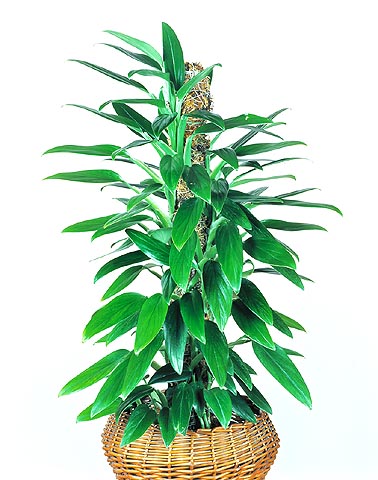Family : Araceae

Text © Pietro Puccio

English translation by Mario Beltramini

Needs, indoor, much light but no direct sun © Giuseppe Mazza
The name of the genus is the combination of the Greek words “philos” = friend and “déndron” = tree, with reference to the usual climbing appearance of the plants belonging to this genus; the name of the species is the combination of the Latin words “gutta” = drop and “fero” = to carry, with reference to the formation of droplets of water on the borders of the foliar lamina.
Semiepiphytic, climbing, evergreen herbaceous, hanging at times, or crawling on the ground with stems at times ramified, of about 1 cm of diameter, rooting at the nodes; 5-18 cm long petioles, winged for almost all their length, oblong or elliptic leaves, sharp on the apex, those of the stems crawling on the ground, are up to 14 cm long and about the half broad, those on the climbing stems are 15-25 cm long and 10-15 cm broad with 2-15 cm internodes, whilst the hanging stems are at times leafless for long segments, even up to 4 m of length, with up to 30 cm internodes.
The inflorescence is formed by a 10-16 cm long spadix, with unisexual flowers, the female ones occupy the lower part for about 5 cm of length, the male ones the remainder, the female zone is green and the male white; the spadix is surrounded by a yellowish-green spathe, long 10-18 cm and about 5 cm broad, tubular in the inferior part; the fruits are white, 6×4 mm, oblong berries, containing 2-3 seeds. It reproduces by seed, air layering, apical cutting and by portions of stem.
The plant can be cultivated in open spaces when in tropical and humid subtropical regions, in shady locations, to cover the soil, or left climbing on trees on which it adheres thanks its aerial roots. When in pot for indoor decoration, is kept climbing on supports covered by bog moss or synthetic material capable to maintain the humidity, and is to be placed in a luminous position, provided far from direct sun, in spaces with temperatures over 14-16°C, best around 20-22°C.
It needs very porous substrata, draining and rich of organic substance; watering must be frequent in summer, reduced in winter, always avoiding water stagnations which can be cause of rottenness.
All parts of the plant contain toxic substances, in particular calcium oxalate, which can be irritating.
Synonyms: Caladium guttiferum Poepp. ex Kunth (1841); Philodendron tessmannii K.Krause (1932); Philodendron krukovii Gleason (1933); Philodendron inaequilaterum subsp. anthoblastum G.S.Bunting (1986).
